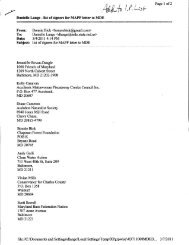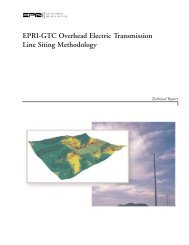Mid-Atlantic Power Pathway Chalk Point Substation to Indian River ...
Mid-Atlantic Power Pathway Chalk Point Substation to Indian River ...
Mid-Atlantic Power Pathway Chalk Point Substation to Indian River ...
You also want an ePaper? Increase the reach of your titles
YUMPU automatically turns print PDFs into web optimized ePapers that Google loves.
<strong>Mid</strong>-<strong>Atlantic</strong> <strong>Power</strong> <strong>Pathway</strong> Environmental Review Document<br />
<strong>Chalk</strong> <strong>Point</strong> <strong>Substation</strong> <strong>to</strong> <strong>Indian</strong> <strong>River</strong> <strong>Substation</strong> Volume II – Environmental Analysis of<br />
April 13, 2011 <strong>Chalk</strong> <strong>Point</strong> <strong>Substation</strong> <strong>to</strong> MD/DE State Line<br />
Table 1.2-1 (continued)<br />
Soil Series Within the Project Right-of-Way and Project Boundaries<br />
Soil Series Description<br />
Runclint The Runclint series consists of very deep excessively drained soils on uplands and<br />
alluvial terraces. They formed in unconsolidated sandy alluvial and marine sediments.<br />
Typically these soils have a dark brown surface layer 9 inches thick and a subsurface<br />
layer from 9 <strong>to</strong> 22 inches of yellowish brown sand. The subsoil between 22 and 40<br />
inches is yellowish red sand. The substratum from 40 <strong>to</strong> 60 inches is yellowish brown<br />
sand. From 60 <strong>to</strong> 72 inches it is mottled stratified sand through sandy clay loam. This<br />
soil is excessively drained. The slowest permeability within 60 inches is moderate.<br />
Available water capacity is moderate <strong>to</strong> high and shrink swell potential is low. This soil<br />
is not flooded and is not ponded. The <strong>to</strong>p of the seasonal high water table is at 45 <strong>to</strong> 60<br />
inches. There are no saline horizons. This component is not a hydric soil.<br />
Sassafras The Sassafras series consists of deep well-drained soils on uplands. They formed in<br />
marine or alluvial Coastal Plain sediments. Typically, these soils have a brown gravelly<br />
sandy loam surface layer, 9 inches thick. The subsoil, from 9 <strong>to</strong> 21 inches, is yellowishbrown<br />
loam, from 21 <strong>to</strong> 32 inches, is brown sandy clay loam, and, from 32 <strong>to</strong> 40 in., is<br />
strong brown sandy loam. The substratum, from 40 <strong>to</strong> 52 inches, is strong brown<br />
gravelly sandy loam and, from 52 <strong>to</strong> 70 in., is brownish-yellow loamy sand. Depth <strong>to</strong> a<br />
root restrictive layer is greater than 60 inches. Water movement in the most restrictive<br />
layer is moderately high. Available water <strong>to</strong> a depth of 60 inches is moderate. Shrinkswell<br />
potential is low. This soil is not flooded. It is not ponded. There is no zone of<br />
water saturation within a depth of 72 inches. Organic matter content in the surface<br />
horizon is about 2 percent. This soil does not meet hydric criteria.<br />
Sunken The Sunken series consists of very deep very poorly drained soils formed in loamy<br />
eolian or alluvial deposits overlying sandy sediments of the <strong>Mid</strong>-<strong>Atlantic</strong> Coastal Plain.<br />
They are on submerging uplands along tidal bays and rivers. Typically, the surface is<br />
dark brown mucky silt loam 6 inches thick. The subsurface layer is light gray silt loam<br />
<strong>to</strong> 18 inches. The subsoil is light gray silty clay loam <strong>to</strong> 38 inches. The substratum from<br />
38 <strong>to</strong> 72 inches is gray very fine sandy loam and light olive gray fine sand. This<br />
component is on flats, lowlands, submerged upland tidal marshes. The parent material<br />
consists of silty eolian deposits over fluviomarine sediments. Depth <strong>to</strong> a root restrictive<br />
layer is greater than 60 inches. Water movement in the most restrictive layer is<br />
moderately low. Available water <strong>to</strong> a depth of 60 inches is very high. Shrink-swell<br />
potential is low. This soil is occasionally flooded. It is occasionally ponded. A seasonal<br />
zone of water saturation is at 5 inches year-round. Organic matter content in the surface<br />
horizon is about 66 percent. This soil meets hydric criteria. The soil has a moderately<br />
saline horizon within 30 inches of the soil surface. The soil has a moderately sodic<br />
horizon within 30 inches of the soil surface.<br />
Tidal Marsh Tidal Marsh consists of very deep very poorly drained soils on tidal flats subject <strong>to</strong><br />
inundation by salt water twice daily. They formed in organic material 16 <strong>to</strong> 51 inches<br />
thick over loamy mineral deposits. Salt content in the soil ranges from 1,000 <strong>to</strong> 40,000<br />
parts per million. Typically, the layers from 0 <strong>to</strong> 48 inches are very dark gray and dark<br />
olive gray hemic materials. The substratum from 48 <strong>to</strong> 99 inches is very dark gray silt<br />
loam.<br />
1-26




